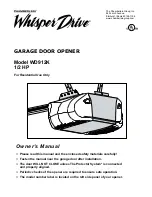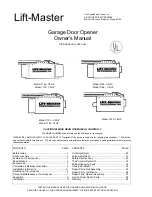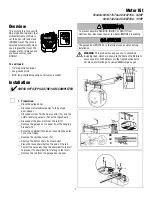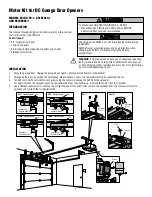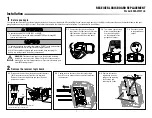
12
EN
5.
Maintenance
The automation must be subjected to maintenance work on a regular
basis in order to guarantee it lasts.
CAUTION! - The maintenance operations must be per-
formed in strict compliance with the safety directions provid-
ed in this manual and according to the applicable legislation
and standards.
If other devices are present, follow the directions provided in the cor-
responding maintenance schedule.
01.
OVO requires scheduled maintenance work every 6 months or
3,000 manoeuvres after previous maintenance.
02.
Disconnect any source of electric power.
03.
Check for any deterioration in automation system components,
paying special attention to erosion or oxidation of the structural parts.
Replace any parts which are below the required standard.
04.
Check the wear and tear on the moving parts: belt, carriage, pin-
ions and the door components; replace them if necessary.
05.
Connect the electric power sources up again, and carry out all
the tests and checks described in section 4.1 (“Testing”).
6.
Disposal of the
product
This product constitutes an integral part of the automation system,
therefore it must be disposed of along with the latter.
Likewise for installation operations, when the product reaches its
end-of-life, decommissioning operations must be performed by
qualified personnel.
This product is made up of different types of material, some of which
can be recycled while others must be disposed of. Seek information
on the recycling and disposal systems available in your area for this
product category.
CAUTION!
- Some parts of the product may contain pol-
lutants or hazardous substances that could cause serious
damage to the environment or human health if released into
the environment.
As indicated by the adjacent symbol, it is strictly forbid-
den to dispose of this product together with domestic
waste. Therefore, implement separate waste collec-
tion criteria for disposal according to the regulations in
force in your area, or return the product to the dealer
when purchasing a new equivalent version.
CAUTION! - Local legislation may include the application
of serious fines in the event of improper disposal of this prod
-
uct.
6.1 -
Disposal of the buffer battery
(if present)
CAUTION!
The empty battery will contain toxic substances
and must not be thrown out with ordinary rubbish.
It should be disposed of according to the "separate" refuse collection
procedures in effect in your local area.
7.
Additional
information
7.1 -
Programming keys
The OVO control unit is fitted with 3 keys which can be used both for
the control of the unit during testing and the programming procedure:
P1
Within the first 10 seconds after power-up, perform
the "RADIO" function to memorise or delete the radio
transmitters used with OVO.
After this time interval, the key is no longer used.
P2
The
P2
key stops the manoeuvre; if pressed for more than
5 seconds, it enables programming mode as described
below.
P3
The
P3
key enables you to control door opening and
closing or scroll through the programming steps.
P3
P1
P2
7.2 -
Programming
The OVO control unit is equipped with a number of programmable
functions; function settings are entered using 2 keys on the control
unit:
P3
and
P2
. They are displayed by means of 3 LEDs:
L1
,
L2
and
L3
.
There are two types of programming:
Programming on power-up:
this type of programming can only
be performed immediately after switching on OVO. Press and hold
P2
during power-up of the control unit to activate this programming
mode.
Standard programming:
this programming mode can be used at
any time and is activated by pressing and holding
P2
.
For both modes, the programming and programmable functions
available are divided into 2 levels:
Level 1:
functions settable in ON-OFF mode (enabled or disabled). In
this case, the
L1
,
L2
and
L3
LEDS indicate a function: if lit, the func-
tion is enabled; if off, the function is disabled. See Tables 9 and 10.
Level 2:
parameters settable on a scale of values (from 1 to 3). In
this case, each LED (
L1
,
L2
and
L3
) indicates 1 of the 3 possible set
values. See Tables 11 and 12.




































